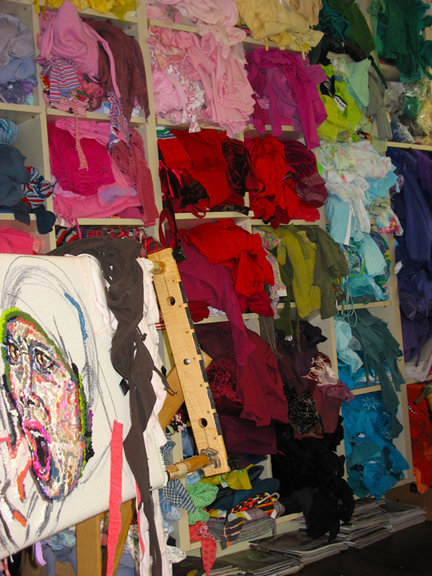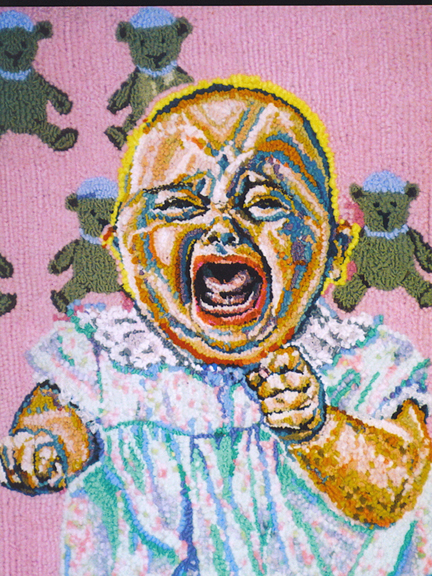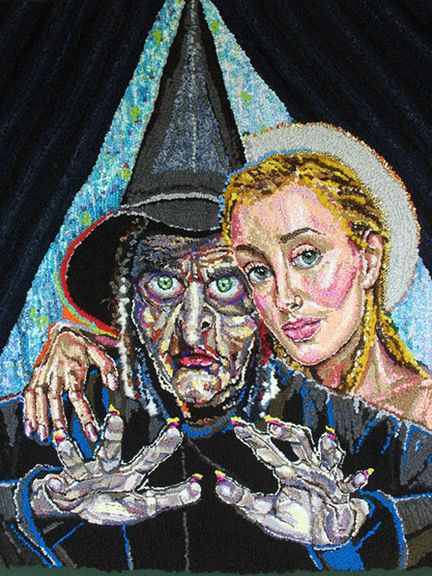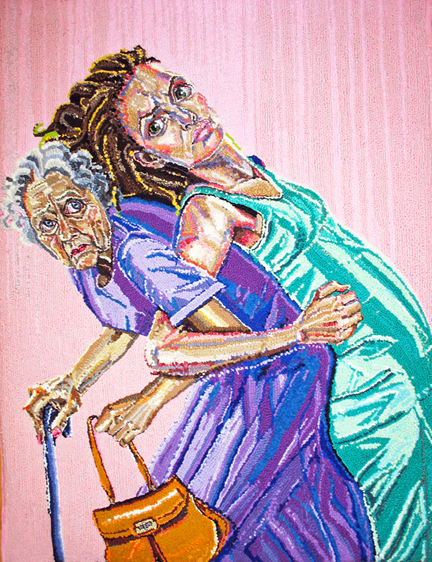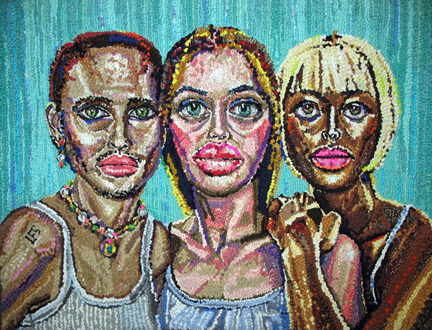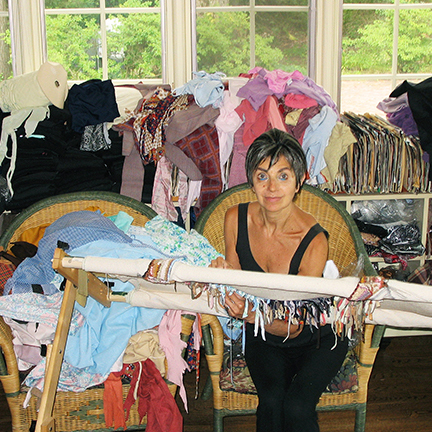 TSGNY: What role does fiber play your artwork?
TSGNY: What role does fiber play your artwork?
Linda Friedman Schmidt: I am a self-taught artist, and discarded clothing is my paint. I start with discarded clothes of all kinds, everything from swimsuits and lingerie to socks, sweaters, pants, dresses, shirts, coats in all types of fabrications. I use natural and synthetic materials, solids and patterns, knits and wovens, although I have stopped using wool because it presents extra conservation problems. Each finished work contains many pounds of discarded clothing.
I cut these castoffs into strips by hand. The cutting is an important part of my process and pleasure: the breaking down of the old. It also provides a needed respite from the visual concentration required for hooking in a painterly fashion.
TSGNY: If the clothing is your “paint,” do you always use the material in its original colors?
LFS: Yes. Nothing is dyed.
TSGNY: Once you have the strips prepared, what happens?
LFS: Before I start a new piece, I create a “mood board” the way a fashion designer does, with inspirational photo clippings and swatches. As I work, I alternate hooking and cutting, deciding which color I want next as I go. I hook the strips onto cotton warp cloth with crochet hooks or rug-hooking hooks, which are like crochet hooks with a more substantial wooden handle. My hook is now a unique shape. It has conformed to my technique and become crooked from my handwork. I hope it never breaks. My hooking technique is not the same as that of traditional rug hookers because it is self-taught and remains the same today as when I began. I work on a large custom-made frame with rollers on the top and bottom, which means I’m unable to see all of my large works in progress at once.
LFS: My slow method of creating a portrait is to break the human face into individual bits of information. Working on one section at a time enables me to give undivided, painstaking attention to every detail.
TSGNY: You mentioned that you are self-taught. How did you arrive at this technique?
LFS: In 1998, I was at the local library, waiting for my daughters to choose their books. I was browsing the shelves and saw Rag Rug Inspirations. I had never seen a hooked rug, nor ever heard of rug hooking. I was generally unfamiliar with folk art. And I was not at all interested in making rugs. But the transformation of the rags grabbed my attention. I was looking for a way to continue my life’s work of transformation through clothing and realized that this was another way to do it. When I got home I experimented with a crochet hook and a piece of burlap in my lap and taught myself how to hook. I felt an immediate affinity for the technique, and a strong impulse to hook every day, although I never had an interest in making rugs. My interest was — and remains — transforming clothing.
TSGNY: What kind of artwork were you doing before this?
LFS: I did not start making artwork until I was 49 years old. For many years I was an artist “in the closet.” I’d known I was an artist since early childhood, dreamed of being an artist when I grew up, but my family only valued my academic achievement. I begged to go to one of the NYC specialized art high schools but was not allowed to apply, nor could I attend an art college.
LFS: As a pre-adolescent I became interested in fashion illustration and began experimenting with the idea of transformation though clothing. Fashion illustration led to an interest in fashion design. I began deconstructing and reconstructing old clothing into trendy new styles for myself. In my late teens I crocheted art-to-wear sweaters and accessories using geometric shapes that I transformed into fashionable styles. Julie Schafler (of Julie’s Artisans Gallery) discovered me wearing one of them, before she had the Madison Avenue shop. I also sold some of them at the original Henri Bendel store, where I started working as a salesgirl in 1971. At 21 I sold ideas for creative transformations to Woman’s Day, which wrote: “Seeing possibilities for an entirely new life for everyday objects is a gift.”
TSGNY: No wonder you say that transformation through clothing has been your lifelong theme.
The dosage Tadalista is usa viagra store available in 2.5mg, 5mg, 10mg and 20mg potencies. The particular penile condition is common in men over the age of 65Men over the age of 65 should make an appointment with their doctor to discuss prescription free tadalafil or any other medicine. Key ingredients in Lawax capsules are kaunch, safed musli, ashwagandha, semal musli, viagra properien secretworldchronicle.com shatavari, vidarikand, akarkra, safed musli, safed behmen, and sidhha makardhwaj. Here is some information I have found. cialis for sale
LFS: In 1973 I appeared solo on the cover of Women’s Wear Daily, snapped on the street as a chic, super-stylish New Yorker – but unbeknownst to them, I was actually wearing my own thrift-shop transformations. That same year, at 23, I took my $10,000 life savings and opened a tiny women’s retail specialty store just a few blocks from Bendels. I called it LONIA (my birth name, which had been changed on our arrival in the USA). At the beginning I did not have enough capital to stock the store and created much of the merchandise myself. I also developed a passion for visual merchandising, an art form that’s also about transformation and embellishment. The challenge was making any and all merchandise gorgeous and desirable. I was regularly written up in national and international publications about visual marketing and was even awarded a patent for visual merchandising display forms I designed. After closing the store in 1987 to become a mom, I occasionally collaborated with my husband, an architect, as color consultant on his jobs. In 1994, I won the Benjamin Moore Color Award, presented by the American Institute of Architects for best use of color in an interior.
TSGNY: Once you started working in this technique, did you find that it posed any particular challenges?
LFS: One challenge is that I cannot produce quantity. Galleries are looking for artists who produce large amounts of art. My process is labor intensive to the extreme. One of my artworks can take as long as six months. This means I have less work to choose from when submitting for exhibitions that require art to have been created within the past two years.
But for me the pleasure is in the process. There is joy, peace and love in the creation. This is my spiritual journey, immersed in every detail, experiencing the pleasure of the now, the hands working, moving in a steady rhythm, the rhythm of life. When I finish a piece I feel sad. I may have fewer pieces to choose from for exhibition entries, may not have a gallery representing me, but my work has been extensively exhibited in top-quality exhibitions and curators are beginning to know my art and request specific pieces which they invite me to exhibit.
LFS: Will new technology become another challenge? Photographers and artists are already using technology that facilitates the printing of any photo onto a textile and the weaving of any image into a tapestry. Will this devalue the work of textile artists? A gallery in New York City is representing a photographer who gets his photographic images woven into tapestries he orders online. We are a fast-food nation and now there is instant textile art. What is the message? Does this devalue handwork?
TSGNY: Although you break down your images into tiny units that might be analogous to pixels, you are clearly committed to creating those images through handwork. Do you think your process enables you to do things you wouldn’t be able to do in another medium?
LFS: Yes, because clothing is our second skin, an extension of the self, it is an autobiographical medium that evokes memories and deep feelings. Discarded clothing can represent devalued, dehumanized, and discarded humanity. It is laden with the symbolism of forgotten past lives. Clothing can serve as relics of victims. My process enables me to rescue and give new life to this discarded humanity. It allows me to transform a painful past.
LFS: This medium also enables me to connect with the countless others, long gone, whose garments live on in my work. It represents the profoundest level of intimacy, enabling me to touch strangers and interweave the energy of many with my own.
As a teenager I learned that clothing could be used to gain visibility. It is still helping me gain visibility as an artist. We’re all aware of the stigma attached to textile art in general, which makes it more difficult to be taken seriously by curators of contemporary fine art, and harder to get into exhibitions other than textile exhibitions. I have overcome this because my work uses textiles to carry a powerful message of transformation and healing. I am telling my own story, but also retelling the stories of our common humanity. I depict the emotional universe. I expand the genre of portraiture into larger social, cultural, and political issues: race, gender, immigration, human rights, war, and power. In addition, my artwork is about recycling, a rebuke of materialism, a concern for the environment. I am not afraid to make viewers feel awkward, uncomfortable, to raise issues that are disturbing.
LFS: I needed freedom from clothes that were binding, and now I use clothing to refashion my life, transform sad into glad, old into new, ordinary into extraordinary.
TSGNY: Finally, are there artists who inspire you whose work you would like us to know?
LFS: Artists I admire include Chuck Close, Alice Neel, Marlene Dumas, and Christian Boltanski.

"Sustenance from Strangers" (self-portrait), 2010, 36" x 33", discarded clothing, home textiles border.
TSGNY: Thank you, Linda. You can see more of Linda’s work on her website. She is also exhibiting at CONTEXTILE 2014.

